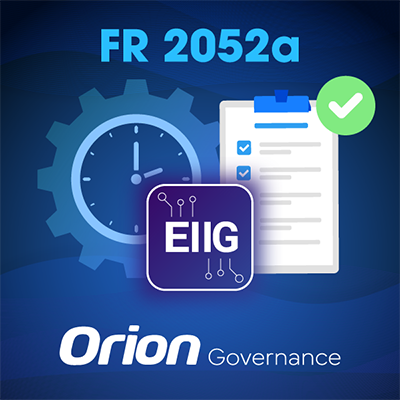The FR 2052a, also known as Complex Institution Liquidity Monitoring Report, is a regulation that requires large complex banking institutions to offer timely liquidity data to identify and monitor liquidity risks. Since complex banking institutions often have diverse and intricate systems, timely and accurate data access and validation becomes a daunting challenge. Orion Governance’s Enterprise Information Intelligence Graph (EIIG), a self-defined data fabric, can help address this challenge and automate the compliance process.

Capture of Comprehensive and Complex Data Flows
FR 2052a requires complex banking institutions to show an aggregated and consolidated view of intra-company flows across their entire data landscape. One of the huge obstacles is that these large and complex banking institutions often have limited capture of data flows from the key systems such as transaction data from their mainframes or applications developed in Python or Java. EIIG solves this problem by automatically ingesting metadata from such complex data sources encompassing the mainframe (PL1, COBOL, JCL, IMS etc.), ETL tools, BI tools, and programming languages like Java and Python and intelligently stitch it into a knowledge graph. Better yet, by leveraging AI/ML to automatically connect business ontologies to the technology assets, business meaning is visualized with ease. By doing so, EIIG enables complex banking institutions to present a consolidated view of the data flows from sources to targets across their subsidiaries and present a unified report. EIIG is based on the premise of a single-model with multiple persona based views. This helps not only the executives, but the business users and the technical users get to the bottom of issues around compliance deficiencies by just drilling down.
Granular Entity-Based Views
According to FR 2052a, just a single, consolidated view is not sufficient to provide meaningful insight into an institution’s liquidity profile. So, the regulation stipulates that large, systemically important banking institutions also provide views by legal entities (parent company, broker/dealer entities, bank entities etc.) to enhance risk supervision by identifying vulnerabilities posed by potential impediments to the movement of liquidity across legal entities. EIIG is architectured in such a way that it provides multiple levels of views in its data lineage presentation. One of the levels is legal entity. What is more, since EIIG scans the code and captures the DNA of the datasets, it shows data lineage with field level details. This capability helps a banking institution to meet the increased granularity requirement of the reporting.
Trusted Data for Modeling and Forecasting
FR 2052a requires institutions to provide projections and forecasts for various liquidity scenarios. Such modeling and forecasting will not be accurate without trusted data. EIIG not only shows how data flows from source to target, before and after transformations, but also augments data quality and propagates trust. It helps achieve this outcome by incorporating data quality and trust metrics to build quality and trust scores. Users can monitor changes of data quality throughout the data pipeline. Besides, with features like term-to-asset mapping, institutions can easily apply FRB’s Liquidity Risk Measurement (LRM) standards. With trusted data, institutions can gain more confidence in their projections and forecasting they share with the regulators.
Transparency for Audit Trail
As in other types of compliances, transparency and traceability is a key requirement. With EIIG, institutions can establish detailed end-to-end data lineage (cross system and technology) and audit trail to satisfy compliance requirements without any manual efforts.
Impact Analysis for Stress Scenarios
FR 2052a mandates institutions to assess their liquidity under various stress scenarios. EIIG offers near real-time impact analysis to help test stress scenarios and evaluate their impact on liquidity positions.
Continuous Monitoring of Changes to Assure Accuracy and Timeliness
Large and complex banking institutions’ data environments are complex and dynamic. Large amount of new data is constantly being created, and new applications rolled out. To assure their FR 2052a reporting is accurate and timely, they need to validate liquidity and risk-related data constantly. To accomplish this task manually is error-prone and unsustainable. EIIG can capture metadata changes and send notifications automatically so that institutions are sure that the data used in their FR 2052a reporting is up to date and precise.
In conclusion, EIIG can help large and complex banking institutions accelerate their compliance with FR 2052a through automatic capture of complex data flows, and establish a single source of truth to ensure the timely and accurate reporting.
Ready to learn more? Schedule a demo to learn more about how EIIG can help your enterprise handle FR 2052a compliance.
About the Author: Niu Bai, Ph.D. is the Head of Global Business Development at Orion Governance, Inc. Connect with Niu on LinkedIn.
Sign up for emails you actually want to read
Join the Orion Governance email list
Recent Articles
Quick Look: Orion Wingman by Orion Governance
Orion Governance EIIG Announces New Generative AI Feature Orion Wingman: Transform Your Data Insights with New AI Tool Get a sneak peek into the future of data management with Orion Governance's Orion Wingman. [...]
Orion Governance EIIG Allows Enterprises to Take Control of Data with One Click
Master Your Data Fast with EIIG Unlock the full potential of your data using Enterprise Information Intelligence Graph (EIIG) by Orion Governance. EIIG empowers your teams to take control of and understand your [...]
Orion Governance EIIG Capabilities and Benefits Video
Fast Overview of EIIG Get an overview of Orion Governance's Enterprise Information Intelligence Graph (EIIG), the all-in-one platform designed to revolutionize how enterprises manage and leverage their data. In less than one minute [...]